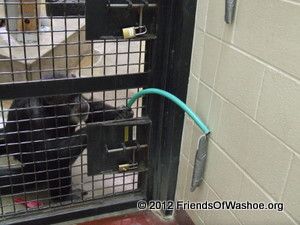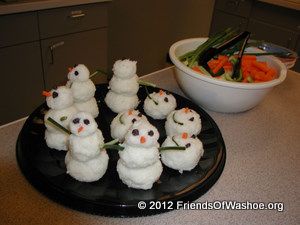

When solving food puzzles the chimpanzees must use critical thinking skills to obtain the food. Special treats and meals are a special part of the lives of this chimpanzee family.
Some forms of food enrichment used at CHCI include:
Kool-Aid Buckets
Enrichers filled buckets with diluted Kool-Aid. They placed the buckets a few feet outside of the chimpanzee enclosures and provided the chimpanzees with tubing or rubber garden hoses. The top of the container could be covered with cardboard with a hole in it so that the chimpanzees had to thread the tube or hose through the hole.
Raisin Boards
Human caregivers cut wood into six-inch lengths and drilled holes at many different angles in the board. The humans then pushed food such as raisins into the holes and gave the boards to the chimpanzees. The chimpanzees used sticks and straws to remove the fruit from the boards.
Ice Cube Treats
Caregivers often filled ice cube trays with juice or other beverages. Human enrichers could also place bits of fruit with water or juice in the ice cube trays. They froze them overnight and served them to the chimpanzees.
Raisin Tubes
Enrichers cut tubing or hose into eight 12-inch lengths and used a straw to push in treats from each end of the tubing. The chimpanzees used sticks and straws to remove the treats from the tubing.
Dipping
Human enrichers folded an 18x6-inch piece of cardboard in half and in one half of the cardboard and cut a hole to hold the plastic container. They duct taped the uncut half on the ground about 18 inches from the chimpanzee enclosure, then filled the plastic container with yogurt or some other sticky substance. They placed the plastic container in the hole and provided the chimpanzees with twigs long enough to reach the plastic container.
Fruit or Vegetable Forage
Caregivers placed a variety of fruits and vegetables throughout all of the enclosures. The fruits and vegetables could be hidden or placed in open areas.
Foraging in Leaves or Straw
Chimpanzee caregivers placed a pile of leaves or straw in the chimpanzees' enclosure, then mixed in raisins, dried fruit, or nuts. The chimpanzees foraged for the treats in the straw or leaves.
Problem Solving
At CHCI, we sometimes taped food and enrichment items 10 feet high on a bare wall. The chimpanzees have devised ingenious ways of procuring the items.
Popcorn Forage
Enrichers filled plastic bags with popcorn and then tossed the bags on the top of the chimpanzee enclosure or hung them on the side of the caging before the chimpanzees entered the area. Other treats, such as, dried cereal, dried fruit, monkey chow, primate dry or any other treat that could fit through the enclosure were sometimes added to the forage.
Snow Cones
Enrichers placed snow in plastic containers and flavored with juice or syrup. Served to chimpanzees.


Peanut Butter Paste
Add to 2 cups peanut butter any of:
1/2 cup raisins
1/2 cup oatmeal
1/2 cup dried fruit
1/2 cup nuts
Caregivers prepared a sticky paste by combining peanut butter, raisins, oatmeal, dried fruit, and nuts, and then smeared small amounts in the chimpanzee enclosure on clean walls, climbing structures, ledges and caging. Treats that are harder to reach often presented a challenge to the chimpanzees.
Easter Egg Forage
Enrichers filled plastic eggs or containers with fruit, monkey chow, primate dry or other treats and hid the containers throughout the chimpanzees' enclosure. Taping or tying the containers closed could be more challenging for the chimpanzees.
Lettuce Forage
The caregivers cut the lettuce and produce into pieces that would fit through caging and filled the plastic bags with lettuce and produce and then tossed the bags onto the top of enclosure or hung outside of the enclosure next to the caging.
Sunflower Seed Forage
Enrichers scattered shelled or unshelled sunflower seeds on the floor outside of chimpanzee caging or below an elevated tunnel and gave the chimpanzees hoses and twigs with which they could reach the seeds. Dried cereal, dried fruit or pretzels could also serve as forage items.
Fruit Kabobs
Caregivers cut fruit into small pieces and threaded on skewer or tubing.
Squirt Bottle Beverage
Enrichers put a beverage (Tea, Koolaid, Lemonade, etc.) in squirt bottle and then squirted the beverage through caging into the chimpanzees mouth.
Cardboard Tubing Wadges
The caregivers coated the inside of the tubing with yogurt and sprinkled in a few pieces of fruit or dried cereal. They covered the ends with plastic wrap and place rubber bands around the tube. They froze the tubes and gave them to the chimpanzees when frozen.
Kool-Aid Water Balloons
Humans used a funnel to place powder in the water balloons and then filled the water balloons by wrapping the balloon mouth around a faucet and slowly turning on the water. They gave the filled balloons to chimpanzees through caging or placed in their enclosure.
Frozen Fruit
Oranges, lemons, tangerines, apples, bananas or other fruit with or without peels are cut up and frozen whole by the caretakers and then given to chimpanzees.
Branch and Flower Forage
The caretakers scattered branches and flowers (lilac branches, cattails, willow branches, dandelions, and other edible plants) throughout the chimpanzees' enclosure, hung on caging, or placed outside or on top of caging.
Frozen Plastic Bottles
The enrichers poured a few inches of water, colored water or juice into the bottom of a plastic container (preferably with a small neck) and added fruit and/or small toys. They then froze the bottle and gave the frozen bottles to the chimpanzees.
Coconuts
Caregivers poked a hole and inserted a straw to drink the coconut milk and placed whole coconuts in the chimpanzees' enclosure.
Watermelons
Watermelons were placed whole into the chimpanzees' enclosure.
Food Garlands
Enrichers threaded food (dried or fresh fruit, candy, nuts, gum, pretzels, Fruit Loop cereal) onto strings of various lengths. They could then hang these strings of food throughout the enclosures, tying them to the inside or outside of caging, taping them to the walls, etc. The chimpanzees had to problem solve - make use of tools, etc. - to obtain the treats. At CHCI, we hung these strands on the Christmas tree outside of the chimpanzee enclosure during the holiday season.
Plastic Bottles
Plastic bottles were disinfected thoroughly and dried completely. Then the bottles were filled with shredded paper and sprinkled with various dried fruits and nuts, usually about five to ten pieces of fruit and/or nuts per bottle. The bottles were then placed in the chimpanzees enclosures. The chimpanzees would find various ways to get the fruits and/or nuts out of the bottles.
Problem Solving Boxes
Enrichment items or food were strung into a garland, which was then hung inside of a box. Additional food or enrichment items could be taped or tied to the side of the box. The box was then placed, upside down, on top of the enclosure. The chimpanzees could then use tools such as hoses or sticks to obtain the items from the puzzle boxes.
Paper Mache Coconuts
Paper mache coconuts were made by using a mixture of 3 parts water to 1 part flour. Newspapers were shredded and dipped into the mixture. The newspapers were then placed around a balloon that had been blown up to make a similar shape of a coconut, leaving an opening at the top for removal of the balloon. When the paper mache balloon had dried, usually 24 hours, the balloon was removed. The coconut coulf be painted brown with non-toxic paints and sprinkled with brown and black small shredded pieces of paper (to simulate the hair on a coconut). Once the coconut was completely dry, shredded paper and five to ten pieces of dried fruit and/or nuts could be placed inside. The coconuts were placed in the chimpanzees enclosures. The chimpanzees would find various ways to get the fruits and/or nuts out of the coconuts.
Placing Food out of Reach
A popular food forage was taping food items (fruits or vegetables, primarily) in plastic bags to points high up on the concrete walls of the indoor and outdoor enclosures. The chimpanzees then had to make use of elements of their environment -- climbing structures, hanging hoses and ropes -- and tools like sticks, ropes, and toys to obtain the food.

